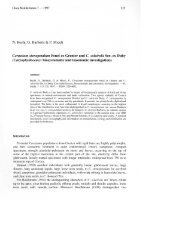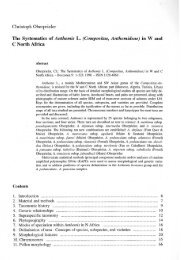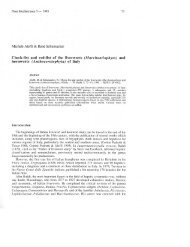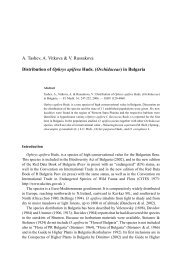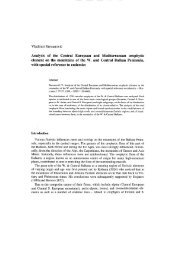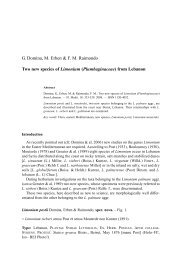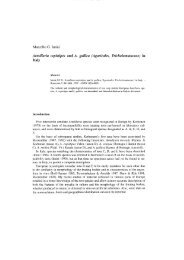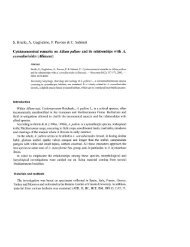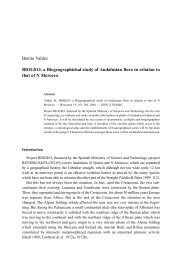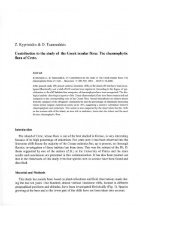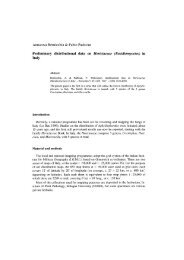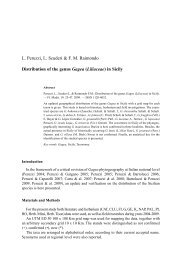Maria Rosa Fernández Calzado & Joaquín Molero ... - Herbmedit.org
Maria Rosa Fernández Calzado & Joaquín Molero ... - Herbmedit.org
Maria Rosa Fernández Calzado & Joaquín Molero ... - Herbmedit.org
Create successful ePaper yourself
Turn your PDF publications into a flip-book with our unique Google optimized e-Paper software.
250 <strong>Fernández</strong> <strong>Calzado</strong> & <strong>Molero</strong> Mesa: High altitude flora of Sierra Nevada (Spain)<br />
Taxa have been classified according to the following life form categories (Raunkiaer<br />
1934): phanerophytes, chamaephytes, hemicryptophytes, geophytes and therophytes.<br />
The list of endemic taxa is done according to Blanca & al. (2002), Castroviejo & al.<br />
(1986-2009) and Rivas-Martínez & al. (1991). The terms “Nevadense” and “Betican” refer<br />
to taxa being restricted to the Sierra Nevada or in the Baetic Cordillera, respectively.<br />
The information about threat categories was compiled using data of Blanca & al. (1999,<br />
2000, 2002) and Bañares & al. (2003).<br />
Results<br />
There are 185 taxa (species and subspecies) recorded in the upper vegetation zone of<br />
Sierra Nevada, which mainly belong to the following families: Poaceae (24 taxa),<br />
Asteraceae (20), Caryophyllaceae (16), Brassicaceae (12), Scrophulariaceae (10) and<br />
Cyperaceae (7).<br />
These taxa are distributed over a variety of endemic plant communities of dry grassland,<br />
scree and cliff communities where hemicryptophytes (61.62 %) and chamaephytes (27.58<br />
%) are dominant, whereas geophytes, therophytes and phanerophytes only account for 10.8<br />
%. The first dominant life form is characteristic in mountainous areas with humidity and<br />
low temperatures; however, our percentage is low if we compare it with other high<br />
European mountains. On the contrary, the chamaephytes percentage, many of them dwarf<br />
chamephytes, is significantly raised possibly due to the Mediterranean character of this<br />
mountain.<br />
As far as the taxa altitudinal distributions are concerned, taking into account the five<br />
bioclimatic zones distinguished by Rivas-Martínez (2007) in Sierra Nevada (thermomediterranean,<br />
mesomediterranean, supramediterranean, oromediterranean and cryoromediterranean),<br />
only 18 taxa were found to belong exclusively to the cryoromediterranean<br />
zone, representing 9.73% of the total number of taxa considered in this study. Some<br />
of these species are just represented by scanty and sparse populations and are considered<br />
to be on the edge of the disappearance. This is the case for taxa that had immigrated during<br />
the Pleistocene glaciations and they remained as relics, i.e. Artemisia umbelliformis,<br />
Draba dubia subsp. laevipes, Papaver lapeyrousianum, Ranunculus glacialis, Sibbaldia<br />
procumbens, Valeriana apula or Saxifraga oppositifolia.<br />
The number of taxa that live within the oro and cryoromediterranean zones is 115<br />
(62.16 %). Some have also arrived in Sierra Nevada during the ice ages and have survived<br />
here in refugee areas, i.e. Alchemilla saxatilis, Asplenium septentrionale or<br />
Gentiana alpine. This group, however, also includes a large number of endemic plants,<br />
i. e. Agrostis canina subsp. granatensis, Arenaria tetraquetra subsp. amabilis, Draba<br />
hispanica subsp. laderoi, Eryngium glaciale, Festuca pseudoeskia, Saxifraga nevadensis,<br />
Senecio nevadensis, Sideritis glacialis, Thymus serpylloides, Trisetum glaciale or<br />
Viola crassiuscula (see appendix).<br />
The remaining 52 taxa (28.11%) live in more than two bioclimatic zones (Fig. 3).<br />
In relation with the chorology and the degree of endemism, the value of Sierra Nevada<br />
is well known. It includes its upper summits where between 30-40 % of ifs flora is exclusive,<br />
increasing up to 80 % in certain ecological niches as scree or rocky areas (Blanca



